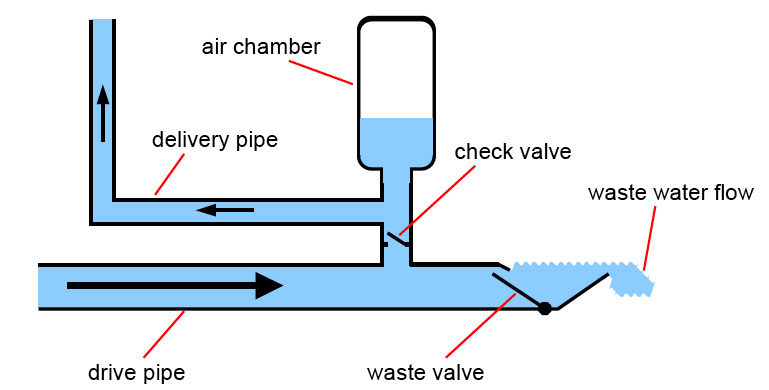Hydraulic Ram pump
| |
A hydraulic ram pump is a water pump powered by water. In areas where natural flows exist with a height difference of the water over a small distance, hydraulic ram pumps can be used to transport water to higher grounds without using electricity or fuel, by using the energy in the speed of the flow to pump a portion of the water up to a much higher level.
Hydraulic Ram pumps
| Advantages | Disadvantages/limitations |
|---|---|
| - Uses renewable energy sources. - If properly designed, can be produced and maintained locally. |
- Water with height difference is needed |
Contents
Capacity
A hydraulic ram pump is powered by a body of water flowing downhill with a height difference. A general rule of thumb is that the water can be pumped 30 times as high as the available drive head (the height difference of the water driving the pump). So a head of 1 m can be used to pump up water to ~30m, while a 7 m head can pump water up to 210 m.
The capacity of a hydraulic ram depends on the scale of the pump, which is often measured in the diameter of the tube delivering the water to the pump. Pumps exist in the range 1" up to 5".
With height difference, the actual difference in vertical height is meant, not the length measured along the slope.
Costs
Additional opportunities
Movies
- Local Hydraulic Ram pump produced by AID Foundation, Philippines
- Installation of Hydraulic Ram pumps in Afghanistan by AID Foundation, Philippines
- Ram pump produced by R.A. Initiatives, Philippines

|
External links
- | General explanation on wikipedia
- | Article on the AID Foundation hydraulic ram, winner of the Ashden Award in 2007
- | Several in-depth articles on the function and construction of hydraulic rams, including detailed drawings of a low-cost and tested design. Development Technology Unit (DTU), University of Warwick, UK
- | Low cost self made pump
- | another low tech pump design



